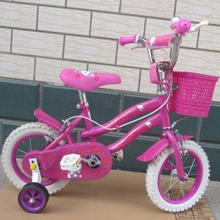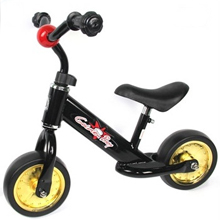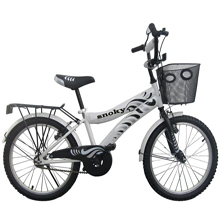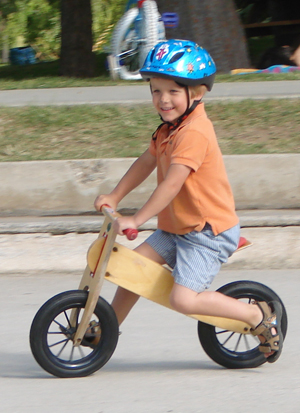
In cash-strapped times even cycling parents may consider economising when it comes to buying a bike for their child; after all, they’ll outgrow it in a few years.
But here’s the thing: you don’t get forever to sell cycling to your kids. They grow up fast and if you want to enjoy riding together, now and in future, your son or daughter needs a bike that’s light enough to manoeuvre easily.
Kids grow so if they are in a child seat or trailer it won't be long until they outgrow it. At 2-4 years they can move on to their own appropriately sized tri-cycle. On a bike, kids can experience/learn the laws of inertia, pedaling, steering, braking and sitting on a saddle. Tricycles don't do much to develop a sense of balance and they can be tippy (excluding low-lying "big wheels").
Most kids try a two-wheeler with training wheels around age 3 years.
Kid Bike Sizes
Children's bike sizes are determined by wheel diameter, not seat height and frame size as is the case with adult bicycles.
| Approximate Age | Child's Inseam | Wheel diameter "bike size" * | Comments: |
| 2-4 years | 14-17 inches 35-42 cm | 12 inches | Most come with training wheels, some are direct drive |
| 4-6 years | 16-20 inches 40-50 cm | 14 inches | Sold at many toy stores and big box stores. |
| 5-8 years | 18-22 inches 45-55 cm | 16 inches | Most have rear coaster breaks and pneumatic tires, some have front hand brakes. |
| 6-9 years | 20-24 inches 50-60 cm | 18 inches | not commonly available |
| 7-10 years | 22-25 inches 55-63 cm | 20 inches | Some models are multi-speed with hand brakes. |
| 9+ years | 24-28 inches 60-72 cm | 24 inches | Can have most of the feature of adult bikes. |
Kid Bike Weight
| Weight makes a bigger difference to the fun and manoeuvrability of a child's bike than yours, because children are smaller, lighter and weaker. A kilo saved from the bike of a six-year-old weighing 30kg is like 2.5kg saved from an adult's. Cranks Children, like adults, need cranks that are about 20 percent their inside leg length. One-tenth of overall height is another oft-quoted rule of thumb, and though it yields a longer measurement (few of us have inside leg measurements that are half our height) it's close enough. Unfortunately the rule of thumb for manufacturers seems to be: stick on whatever ought to be on the next size of bike up. Over-long cranks are as ungainly as they are unergonomic. And they'll ground more easily unless the manufacturer puts the bottom bracket higher, which is the last thing a child needs. Wheels and brakes Don't buy big wheels for small riders, they need scaling down too. While a larger wheel will roll over bumps and kerbs better, it will also be heavier (more inertia), and the steering will be less responsive. It's likely that the reach to the bars will be greater too because the bottom bracket to front axle distance will be greater. | |
Brake levers don't necessarily need scaling down, because you can use two-finger adult levers. They must be within easy reach of the bars though (is there an adjustment screw?), and easy to operate. Check that you can operate the brakes with only the little finger of each hand.
Conclusion:
Never buy children bikes that are too big or heavy for them because it is dangerous. Your child must be able to sit on the bike seat while both feet are flat on the ground and hands are on the handlebar. Children will have a difficult time balancing and maneuvering a bike that is too big and heavy, so don't put them in this vulnerable position as it could prove fatal on an open road. Consider center of balance when choosing a bike. Discuss your options with a bike expert before making your final decision.
written by Nicolas Yang








